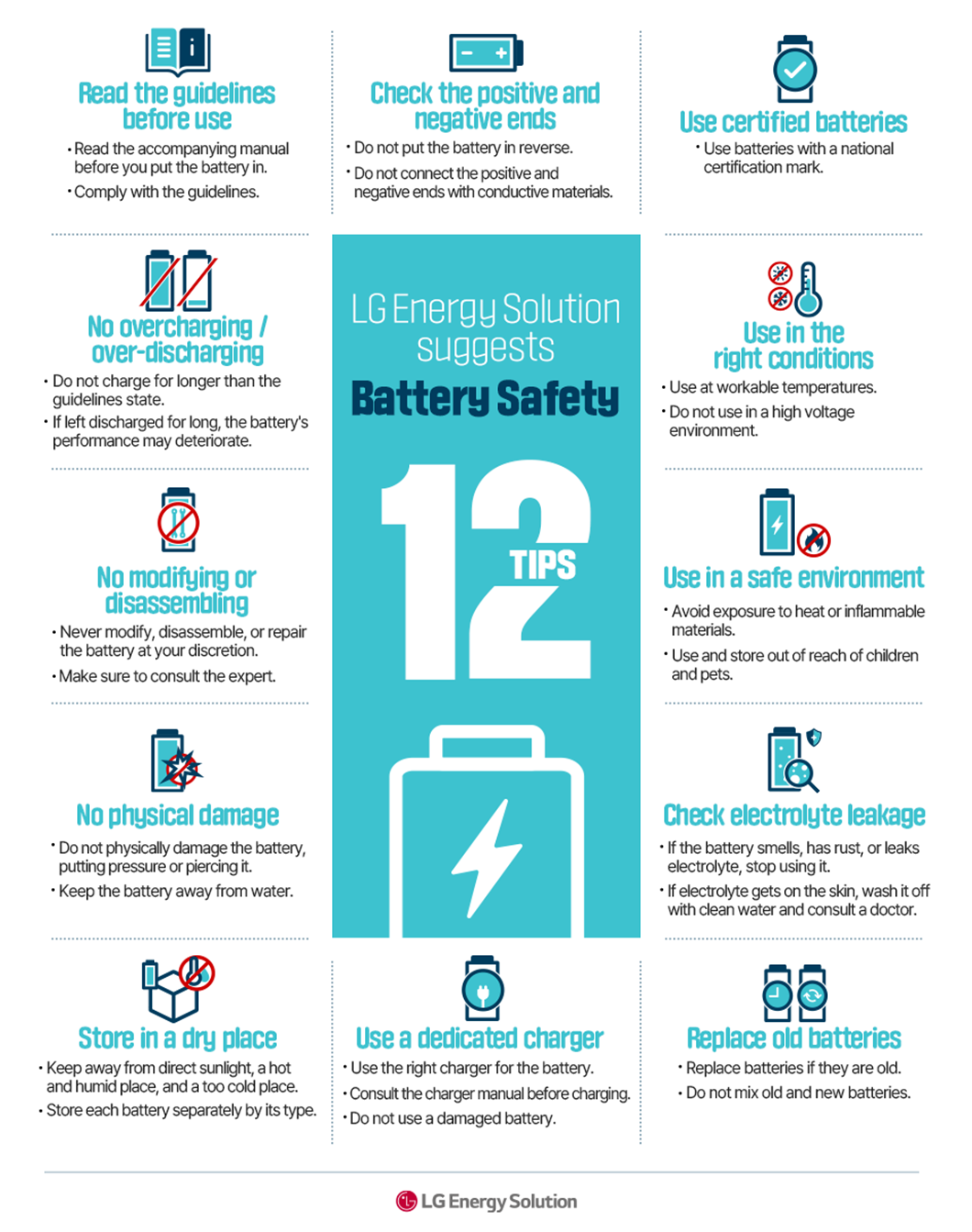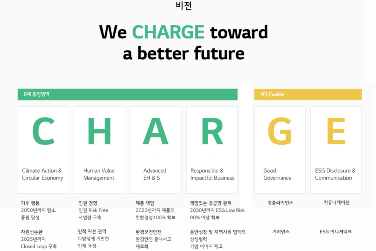We are literally living in the “era of batteries.” Our daily lives are closely connected with a variety of electronic devices including smartphones, laptops, and power chargers as well as electric vehicles, electric scooters, and batteries. LG Energy Solution presents battery safety tips for you to enjoy a safer battery life in the right way. Let’s learn about and practice them!

Q1. Why can’t you connect the cathode (+) and the anode (-) in reverse?
A battery is charged when lithium ions move from the cathode to the anode and releases energy when they move from the anode to the cathode. If a battery is connected in the other way round, that can cause a short circuit, a state where the opposite terminals or electric wires come into contact due to a product malfunction or the user’s fault and excessive current flows with little or no electrical resistance. A short circuit can undermine battery performance and lead to danger such as a fire or overheating. Therefore, putting batteries in the right way is imperative when you use them.
Q2. Why can’t you connect the cathode (+) and the anode (-) with conductive materials (such as metal or metal wires)?
If the cathode (+) and the anode (-) are directly connected to conductive materials (such as metal or metal wires), too much energy goes through a narrow channel at a time and triggers heat. This can lead to a device malfunction and safety problems. Accordingly, randomly connecting the cathode and the anode to conductive materials without insulation treatment is highly dangerous.
Q3. Why do you have to buy batteries with a national certification mark?
Consumers have to purchase and use batteries approved and authorized for sales and use by national or relevant regulatory bodies. The certification mark may differ by countries and is bestowed upon products that passed tests of testing agencies. It assures the quality and safety of the product.
In Korea, the Korea Certification (KC) Mark system evaluates and confirms safety and conformity of battery products used domestically. Distribution and sales of products without a KC mark are considered illegal under the Electrical Appliances and Household Products Safety Management Act. The Korean Agency for Technology and Standards also publicly states a ban on the use of loose battery cells that do not have a KC mark.
Q4. What is the “protection circuit” of a battery and what does it do?
A protection circuit is a safety device for controlling and protecting a battery that is in an unstable and abnormal state caused by overcharge, over-discharge, or overcurrent. Using a battery without a protection circuit can cause safety problems such as a fire or an explosion as it cannot handle the heat generated from the high output.
Nevertheless, illegal sales and purchases of loose battery cells without protection circuits (such as 18650, 20700, and 21700) are so rampant that they have become global issues. In response, the U.S. Consumer Product Safety Commission warned against the use of loose 18650 battery cells that do not have protection circuits. Therefore, you should not buy batteries through unverified channels either from home or abroad.
Q5. Why can’t individuals just disassemble, modify, or repair batteries?
Battery manufacturers discourage consumers from attempting to disassemble, modify or repair batteries at their discretion. If individuals without expertise or technique attempt to modify a battery, they may inflict damage to the protection circuit of the battery, which can lead to a fire or an explosion. Therefore, an expert with proven experience is essential to do the job. Above all, even in case the product is damaged or a safety accident happens as a result of such attempts, the manufacturer is not obliged to compensate the consumer because it is caused by the consumer’s fault. So, please follow the manufacturer’s instructions.
Q6. Why can’t batteries come into contact with water or be submerged?
Quality-certified batteries are waterproofed and protected enough so that the risks of battery malfunction or an electrical injury are low even when they come into contact with water or are submerged. However, since a battery of which the inside may have been damaged from an external shock can cause a safety issue, it is in your interest that you keep the battery away from water. If an electronic device has been submerged for a long time with batteries in it, the metal part may corrode and give rise to problems in the charging terminal and inside of the device. In that case, you should first cut the power off and avoid direct contact with it.
Q7. Why can’t you overcharge or over-discharge batteries?
Quality-certified batteries can protect themselves from overcharge or over-discharge because they have protection circuits. If a battery has internal damage or has been used for a long time, continuous overcharge may render the battery unstable, undermine its capacity and life, and cause safety risks such as overheating or a fire. It is better to remove the charging cable from the device when charging is completed. Over-discharging also can damage the battery. It may push the voltage down below the rated level, damaging the current collector and undermining the performance.
Q8. Why can’t you store or use batteries in an extremely cold environment?
If too low temperature makes the electrolyte and the inside of the battery cold, the move of lithium ions is slowed and the battery efficiency decreases. Lithium ions in a battery that is discharged in cold temperature normally can recover their speed when put back in higher temperature. However, drastic temperature changes may damage the battery ingredients and impact the battery’s performance and life. Therefore, it is important to avoid storing and using batteries in an extremely cold environment and to prepare for temperature changes.
Q9. Why can’t you store batteries in a hot or humid environment?
A battery exposed to a humid environment for a long time may corrode due to steam, which can lead to discharge or problems in battery contacts. This eventually can cut the battery’s life expectancy and undermine its performance. Also, exposure to a hot environment for a long time may gradually heat up the battery, damaging the internal structure of the battery and causing safety issues such as a fire or an explosion. For long-term storage, batteries need to be stored in low temperature and a dry environment.
Q10. Why do you have to check electrolyte leakage?
The electrolyte of a lithium-ion battery consists of electrolyte salt (lithium salt), solvents, and additives and can be categorized largely into acid and alkaline electrolytes. They are both corrosive and can influence the human body. If electrolyte is leaked and you inhale or intake it, you may suffer from a headache, nausea, or shortness of breath. When in contact with skin, it can cause irritation and inflammation. Therefore, you should be careful not to expose your body parts to electrolyte, and if you are exposed, make sure to wash it off with clean water and consult a doctor.
Q11. Why can’t you mix old and new batteries?
Old batteries lose capacity with time and come to have unstable voltage. When used with new batteries, the old batteries may leak electrolyte because the capacity and voltage are different, and that can damage the device. As for electronic devices, users are advised to replace batteries when the maximum capacity goes down below 80%. Also, they are recommended to use batteries of the same type and capacity for the safe and right use of batteries.
Q12. Why do you have to use a dedicated charger for a battery-powered product?
A dedicated charger that meets battery requirements ensures safe and fast charging, offering the optimum current and voltage for the product. Use of batteries that do not meet the requirements can cause overcharge or overcurrent, which can shorten battery life, reduce performance, or damage the product. Also, users are recommended to charge using the dedicated charger in the operating temperature of the battery. The dedicated charger is tested enough to be assured by the manufacturer, and if the user employs a general charger and ends up damaging the product, the manufacturer may not compensate for that.
For the safe and right use of batteries, the most important things are to purchase safe batteries with an official certification mark and to check the instructions and guidelines of the manufacturer before using the batteries. Make sure to remember the two points!





